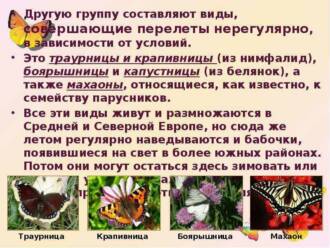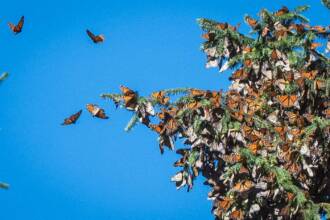Dark orange wings with black stripes and two rows of small white spots along the edges - the monarch butterfly (Danaus plexippus) is easily recognizable by its characteristic bright color. This is an insect whose wingspan is about 10 cm, overcomes huge distances and is even able to fly over the Atlantic Ocean. Let's find out where such an unusual name came from, how long the monarch butterfly lives and how it continues its race.

First mentions and history of the name
These insects have been known to science for several centuries. The species of butterflies was first described in 1758, when Carl Linnaeus mentioned it in his work "The System of Nature" under the name "Papilio plexippus". However, after 32 years, the naturalist Jan Krzysztof Kluk assigned the insect to another genus - "Danaus plexippus". Most likely, this name was given in honor of one of the characters in the mythology of Ancient Greece. Consonant names occur twice. One belonged to the son of the Egyptian ruler Danae. The second is Danae, his great-great-granddaughter.
The word "monarch" in the description of the species was first mentioned in 1874 by entomologist Samuel Scudder from America. Sometimes it is called a butterfly with royal name. He pointed out that this insect among butterflies is one of the largest and “rules vast lands” - lives in vast territories. The butterfly does not tolerate cold and cannot find food in its native lands in winter, therefore it is forced to move to warm countries. In addition, if you study the pictures, it becomes clear that it looks truly majestic due to its coloring.
Is there a serious threat of extinction for this species or is it not? Currently, the number has declined sharply due to deforestation, so the butterfly is carefully protected in different countries.

Description of the species
Butterfly danaid monarch enters Nymphalidae family. When the wings of an insect are spread, they reach from 8 to 10 cm. There are individuals of different colors. Most often you can see red-brown butterflies. Males are larger than females, their wings are larger and lighter.
Most insects are common in North America. You can also see them in Australia and Africa. Butterflies have been in New Zealand since the 19th century. Nowadays, she lives in the Canaries, Madeira and in Russia. Danaid butterflies They also live in reserves created in different countries. One of the largest and most popular is located in Mexico.

Monarch butterflies do not like sudden changes in temperature, because of the cold they can die. The flight begins in the spring. The path of insects can be up to 4 thousand kilometers, and the speed is about 35 km / h. The female carries the eggs inside herself during migration to lay them in a new location.
The lifespan of a caterpillar is only 42 days. During this time, she manages to eat food, the weight of which is 15 thousand times her own. The characteristic pattern on the body of the insect, which you can see in the photo, saves it from birds. Predators immediately understand that the caterpillar is poisonous, thanks to the stripes of black, white and yellow. The fact is that this species eats mainly the leaves of plants containing toxic enzymes. For this reason, poison gradually accumulates in the body.

An adult caterpillar reaches a length of up to 7 cm. It usually lays its eggs on a milkweed, the leaves of which it prefers to eat. With the onset of cold weather, butterflies drink a lot of nectar - you need to prepare for the flight. After the insects have reached the wintering place, they plunge into hibernation, which lasts an average of four months. To better keep warm, you have to sleep in colonies - insects stick to the branches from all sides and hang on them like bunches of grapes.
Waking up after hibernation of monarch butterflies begins with one simple action that helps to warm up before the flight - they plow open wingsand then start waving them around. Nutrition now consists mainly of plants that secrete milky sap. The diet of butterflies includes flower nectar - insects choose asters, lilacs and clover.

Butterfly migration
Migration is the process of moving a population, when individuals leave one area and fly to another. It happens that when the right weather conditions occur, insects return to their native lands. Only 250 species of butterflies migrate, of which only 20 are able to endure a long flight.. This phenomenon has been studied since the middle of the last century. Scientists put marks on the wings of butterflies, which they make using oil paints of different colors:
- yellow in Austria;
- reds in Switzerland;
- green in Germany.

In America, another way of studying migration is popular. The monarch butterfly on its wings receives a tiny etiquette, where its individual number is indicated. Scientists also examine the DNA of migrating individuals, thanks to which they determine which population they belong to.
In North America, the monarch butterfly makes its way south. Usually the migration of butterflies takes place from the end of summer until the first frost. Most of the insects that were east of the Rocky Mountains end up in the Mariposa Monarca Biosphere Reserve, located in the state of Michoacán.. On the trees there you can see a huge number of individuals - up to 100 thousand at a time. Travel time significantly exceeds the life of an insect in natural conditions.. The spring migration of butterflies takes place in the states of Texas and Oklahoma.
In America, the species is also common - Danaus plexippus Megalippe. These butterflies do not migrate, as the mild climate in their place of residence completely suits them.

reproduction
The usual time for the mating season of monarch butterflies is spring. Before going to warm countries, males begin to court females - they overtake in flight, trying to attract attention, as if stroking their wings, and then pushing the chosen ones down. A mating process takes place during which the males pass on a special sperm pouch. It is not only required for procreation, but also helps the butterfly not lose strength during migration. Females lay white or yellow cone-shaped eggs either in spring or summer. The eggs are about 1 cm long and 1 mm wide.

It takes only four days for a caterpillar to appear. First of all, she eats her own egg, and then moves on to the leaves. Gardeners do not like monarch butterfly caterpillars because of excessive gluttony - uninvited guests can cause serious damage to agriculture. For two weeks of life, insects try to get as full as possible in order to accumulate the necessary energy..
Then comes the next stage - pupae. At this time, the caterpillar hangs on a twig or leaf. Her body is shaped like the letter "J". The insect molts, shedding the old shell. Then the pupa changes color - it becomes darker and more transparent. Before the appearance of a mature individual, an average of 14 days passes. The butterfly slowly spreads dry wings, which gradually fill with liquid. The insect waits until they become rigid, and then goes in search of food.
How long does a monarch butterfly live? It is known that the period of its earthly journey under natural conditions is on average from 14 to 60 days. Migratory butterflies can live much longer - up to seven months.

These butterflies are so common and loved in America that they are the symbols of the following states:
- Alabama;
- Illinois;
- Idaho;
- Texas;
- West Virginia;
- Vermont.
The monarch butterfly was even nominated in 1990 as America's National Insect. However, it was not possible to obtain the approval of legislators. Often in schools in the classroom they give out caterpillars for cultivation. Later, the children release mature individuals with incredibly beautiful orange wings to freedom.
Read more:





